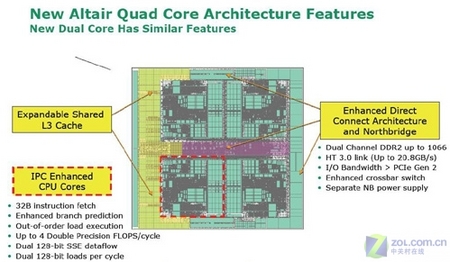I'll be a little surprised if the 45nm version isnt true quad based on the fact that the projected cache is cut to 6mb from the current 8mb which would be a little strange considering its going to be using the smaller process.
No, L2 cache would rise from 4MB to 6MB on the dual cores and from 2 x 4MB to 2 x 6MB on the quad cores.....
Intels current strategy is to do a direct shrink (or near enough, L2 cache is in relative terms a trivial addition and the SSE4 instructions could be being achived by tweaking the Micro Ops or enabling existing silicon that wasn't validated in time for Conroe since it was pulled in a couple quarters) to a new process technology as it enables them to work on perfecting it from a known base. Nehalem will follow a year later. Just look at the nightmare that came about from the massive changes in the Prescott core compared to Northwood and the maturing 90nm process.
Creating a natively quad core chip means having to rework the L2 cache since you now have 4 cores accessing it and if you are going to sit 2 pairs of cores on a single die to avoid this redesign then why have them on a single die?
Look at the transistion from 90nm to 65nm and they actually SPLIT the cores of the Pentium D, I'm not suggesting they're are about to make Core 2 into a single core as it would be detrimental and unnecessary, but having the a pair of dice on a single substraite offers advantages such as including improved yields and more flexibility in production (suddenly finding massive demand for quad core, no problem just start packaging more together as a pair).
Lets face it, AMD can argue about 'true' quad core all they like, at the end of the day it all smacks a bit of desperation. I'm not going to go "Well, the Intel is faster but the AMD chip is a single piece of silicon so I'll buy that"

As for octo-core, well if you are going to go two sockets then Intel can sell you one of those already.
Oh and we're also staring an FSB boost in the face for the next intel chipset which would make absolutly zero sense in the desktop area currently since its not saturated even with kentsfield. The FSB increase could be to help native quadcore as well as octo-core processors, which again are going to be released next year. I just dont see Intel wiring cores together for over a year like you're saying, its not their style.
In some applications Kentsfield benefits quite a lot from a 1333FSB actually, and a native quad core would have less of a dependancy (assuming the same clock speed and cache shared between all four cores) as there would be no traffic hitting the FSB for cache coheriency.


